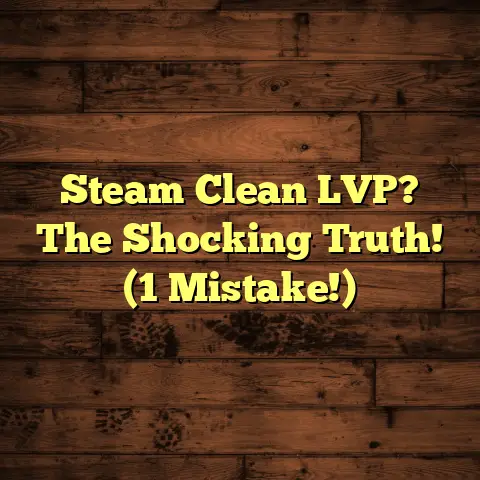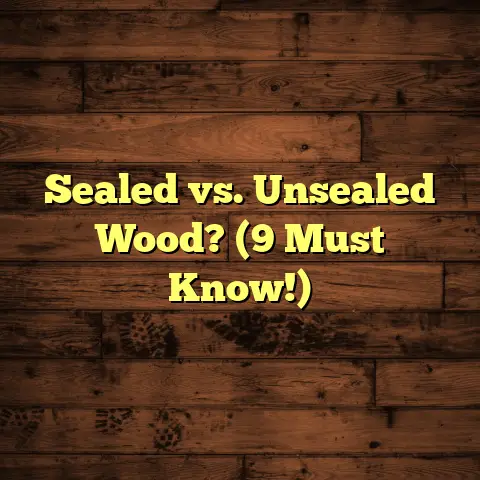Castile Soap Recipes For Floor Cleaning? (1 Tip You Need!)
Have you ever considered how the taste of a dish can be influenced by the quality of its ingredients, just as the cleanliness of your floors can be transformed by the right cleaning solutions?
I’ve seen it countless times in my years as a flooring contractor: homeowners struggling with dull, sticky floors, often because they’re using harsh chemicals or simply the wrong cleaning products.
That’s where Castile soap comes in.
It’s a game-changer, and I’m going to show you why.
This article will dive into various recipes for using Castile soap for cleaning floors, alongside one crucial tip that can elevate your cleaning game.
Section 1: Understanding Castile Soap
What Exactly Is Castile Soap?
Castile soap is a plant-based soap traditionally made from olive oil, water, and lye (sodium hydroxide or potassium hydroxide).
The name “Castile” comes from the Castile region of Spain, where it originated.
Unlike many commercial soaps that contain synthetic detergents, animal fats, and harsh chemicals, true Castile soap is biodegradable and gentle.
The Benefits of Castile Soap in Cleaning
Why am I so passionate about Castile soap for cleaning? Here’s why:
-
Biodegradable: It breaks down naturally, reducing its impact on the environment.
-
Gentle: It’s mild enough for sensitive skin and won’t damage most surfaces.
-
Effective: It cuts through dirt and grime without leaving behind harsh residues.
-
Versatile: You can use it for everything from washing your body to cleaning your floors!
I’ve personally used Castile soap to clean everything from delicate hardwood to grimy tile, and I’m always impressed with the results.
Why Eco-Conscious Households Love It
More and more people are looking for eco-friendly cleaning options, and Castile soap fits the bill perfectly.
It’s a natural, sustainable choice that reduces your reliance on harmful chemicals.
Plus, a little goes a long way, making it a cost-effective option too.
Section 2: The Importance of Floor Cleaning
Health, Safety, and Sparkling Floors
Clean floors aren’t just about aesthetics; they’re crucial for health and safety.
Think about it: floors are magnets for dirt, dust, allergens, and bacteria.
Regular cleaning helps prevent slips, reduces allergy symptoms, and creates a healthier living environment.
According to the EPA, improved indoor air quality can reduce respiratory issues by up to 60%.
That’s a statistic that really hits home, especially for families with young children or allergy sufferers.
Different Floors, Different Needs
Here’s the thing: not all floors are created equal.
Hardwood, tile, laminate, and stone each have unique cleaning requirements.
What works wonders on tile might damage hardwood.
That’s where the adaptability of Castile soap shines.
With the right recipe and technique, you can safely and effectively clean almost any type of flooring.
Section 3: Basic Castile Soap Floor Cleaning Recipe
The Foundation: A Simple, Effective Solution
Let’s start with the basics. This recipe is my go-to for general floor cleaning.
Ingredients:
- 1/4 cup of liquid Castile soap
- 1 gallon of warm water
- Optional: 10-20 drops of essential oils (like tea tree or lavender for added fragrance and antibacterial properties)
Instructions:
- Mix the Castile soap and warm water in a bucket.
- Dip a microfiber mop into the solution, wring out excess water, and mop the floor.
- Allow the floor to air dry.
How Well Does It Work?
This basic recipe is surprisingly effective on a variety of flooring types.
I’ve used it on:
-
Tile: It effectively removes dirt and grime without leaving a residue.
-
Laminate: It cleans gently without damaging the surface.
-
Sealed Hardwood: While you need to be careful with moisture, this diluted solution works well for routine cleaning.
It’s a great starting point, but let’s explore some more specialized recipes for specific flooring needs.
Section 4: Advanced Castile Soap Recipes for Specific Flooring Needs
Recipe for Hardwood Floors
Hardwood floors require a delicate touch. Too much water can cause warping and damage.
Ingredients:
- 1/4 cup Castile soap
- 1 gallon warm water
- 1/2 cup vinegar (for added shine)
Instructions and Tips:
- Mix the ingredients in a bucket.
- Dampen a microfiber mop with the solution, wringing out as much water as possible.
- Mop the floor in the direction of the wood grain.
- Dry the floor immediately with a clean, dry cloth to prevent water damage.
Key Tip: Never let water pool on hardwood floors.
Recipe for Tile Floors
Tile floors are generally more durable than hardwood, but grout can be a challenge.
Ingredients:
- 1/4 cup Castile soap
- 1 gallon of warm water
- 1 tablespoon baking soda (for scrubbing power)
Instructions:
- Mix the Castile soap, warm water, and baking soda in a bucket.
- Mop the tile floor with the solution.
- For grout cleaning, make a paste of baking soda and water, apply it to the grout lines, let it sit for a few minutes, and then scrub with a grout brush.
- Rinse the floor with clean water and allow it to air dry.
Recipe for Laminate Floors
Laminate floors can be prone to streaks if not cleaned properly.
Ingredients:
- 1/4 cup Castile soap
- 1 gallon warm water
- 1-2 teaspoons of rubbing alcohol (for streak-free shine)
Instructions:
- Mix the Castile soap, warm water, and rubbing alcohol in a bucket.
- Dampen a microfiber mop with the solution, wringing out excess water.
- Mop the floor, making sure to avoid excess water.
- Allow the floor to air dry.
Key Tip: The rubbing alcohol helps the water evaporate quickly, preventing streaks.
Recipe for Stone Floors
Stone floors require a pH-neutral cleaner to prevent damage.
Ingredients:
- 1/4 cup Castile soap
- 1 gallon warm water
- 1 tablespoon of olive oil (to nourish the stone)
Instructions:
- Mix the Castile soap, warm water, and olive oil in a bucket.
- Mop the stone floor with the solution.
- Allow the floor to air dry.
Key Tip: The olive oil helps to nourish the stone and prevent it from drying out.
Section 5: One Essential Tip for Using Castile Soap on Floors
The Secret to Success: Dilution is Key!
I’ve seen it happen too many times: someone tries Castile soap, doesn’t dilute it properly, and ends up with a sticky, slippery mess.
That’s why I’m going to share the most crucial tip: Always dilute Castile soap properly before use to avoid residue and ensure optimal cleaning results.
Why Dilution Matters
Castile soap is highly concentrated.
Using it undiluted can leave behind a residue that attracts dirt and makes your floors slippery.
-
Prevents Slippery Floors: Proper dilution ensures that the soap rinses clean, leaving no slippery residue.
-
Avoids Residue Build-Up: Concentrated soap can build up over time, making your floors look dull and dingy.
-
Maximizes Cleaning Power: Diluted Castile soap is still effective at cleaning, but it’s less likely to leave behind a residue.
How This Tip Enhances Your Cleaning
By following this simple tip, you’ll get the most out of your Castile soap cleaning routine.
Your floors will be clean, shiny, and free of residue.
It’s a game-changer, trust me!
Section 6: Additional Tips for Floor Maintenance
Regular Routines for Sparkling Floors
Consistency is key when it comes to floor maintenance. Here’s what I recommend:
- Sweep or vacuum regularly: This removes loose dirt and debris before it gets ground into the floor.
- Mop weekly (or more often if needed): Use one of the Castile soap recipes I’ve shared to keep your floors clean and shiny.
- Clean up spills immediately: Don’t let spills sit on the floor, as they can stain or damage the surface.
Choosing the Right Tools
The right tools can make all the difference. I recommend:
- Microfiber mops: These are gentle on floors and effective at picking up dirt and grime.
- Soft-bristled brushes: These are great for scrubbing grout and other hard-to-reach areas.
- Clean buckets: Use a clean bucket for your cleaning solution and another for rinsing your mop.
Dealing with Tough Stains
Even with regular cleaning, stains can happen.
Here’s how to tackle them with Castile soap:
- Spot Cleaning: For small stains, apply a small amount of diluted Castile soap directly to the stain, let it sit for a few minutes, and then wipe it away with a clean cloth.
- Baking Soda Paste: For tougher stains, make a paste of baking soda and water, apply it to the stain, let it sit for a few hours, and then scrub it away.
- Hydrogen Peroxide: For stubborn stains on light-colored floors, try applying a small amount of hydrogen peroxide, let it sit for a few minutes, and then wipe it away.
Always test in an inconspicuous area first!
Section 7: Conclusion
Castile Soap: Your Floor Cleaning Ally
Castile soap is a versatile, effective, and eco-friendly option for cleaning your floors.
From hardwood to tile, it can handle almost any flooring type with the right recipe and technique.
The Key Takeaway: Dilution is Non-Negotiable
Remember, the most important thing is to dilute Castile soap properly.
This will prevent residue build-up, keep your floors from becoming slippery, and maximize the cleaning power of the soap.
Experiment and Enjoy!
I encourage you to experiment with the recipes I’ve shared and find what works best for your floors.
Cleaning doesn’t have to be a chore; it can be a rewarding experience that leaves your home feeling fresh and clean.
Call to Action
Now it’s your turn!
Share your favorite Castile soap recipes or cleaning tips in the comments section below.
Let’s build a community of clean floor enthusiasts!





